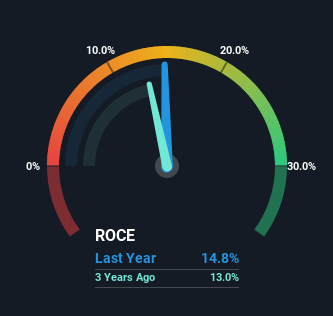Here's What To Make Of Hill & Smith Holdings' (LON:HILS) Decelerating Rates Of Return
What trends should we look for it we want to identify stocks that can multiply in value over the long term? Typically, we'll want to notice a trend of growing return on capital employed (ROCE) and alongside that, an expanding base of capital employed. If you see this, it typically means it's a company with a great business model and plenty of profitable reinvestment opportunities. So, when we ran our eye over Hill & Smith Holdings' (LON:HILS) trend of ROCE, we liked what we saw.
Understanding Return On Capital Employed (ROCE)
For those that aren't sure what ROCE is, it measures the amount of pre-tax profits a company can generate from the capital employed in its business. To calculate this metric for Hill & Smith Holdings, this is the formula:
Return on Capital Employed = Earnings Before Interest and Tax (EBIT) ÷ (Total Assets - Current Liabilities)
0.15 = UK£77m ÷ (UK£673m - UK£154m) (Based on the trailing twelve months to December 2021).
Therefore, Hill & Smith Holdings has an ROCE of 15%. That's a pretty standard return and it's in line with the industry average of 15%.
See our latest analysis for Hill & Smith Holdings
Above you can see how the current ROCE for Hill & Smith Holdings compares to its prior returns on capital, but there's only so much you can tell from the past. If you'd like, you can check out the forecasts from the analysts covering Hill & Smith Holdings here for free.
How Are Returns Trending?
While the returns on capital are good, they haven't moved much. The company has employed 30% more capital in the last five years, and the returns on that capital have remained stable at 15%. 15% is a pretty standard return, and it provides some comfort knowing that Hill & Smith Holdings has consistently earned this amount. Stable returns in this ballpark can be unexciting, but if they can be maintained over the long run, they often provide nice rewards to shareholders.
Our Take On Hill & Smith Holdings' ROCE
To sum it up, Hill & Smith Holdings has simply been reinvesting capital steadily, at those decent rates of return. Despite the good fundamentals, total returns from the stock have been virtually flat over the last five years. That's why we think it'd be worthwhile to look further into this stock given the fundamentals are appealing.
On a separate note, we've found 3 warning signs for Hill & Smith Holdings you'll probably want to know about.
If you want to search for solid companies with great earnings, check out this free list of companies with good balance sheets and impressive returns on equity.
Have feedback on this article? Concerned about the content? Get in touch with us directly. Alternatively, email editorial-team (at) simplywallst.com.
This article by Simply Wall St is general in nature. We provide commentary based on historical data and analyst forecasts only using an unbiased methodology and our articles are not intended to be financial advice. It does not constitute a recommendation to buy or sell any stock, and does not take account of your objectives, or your financial situation. We aim to bring you long-term focused analysis driven by fundamental data. Note that our analysis may not factor in the latest price-sensitive company announcements or qualitative material. Simply Wall St has no position in any stocks mentioned.

 Yahoo Finance
Yahoo Finance 
